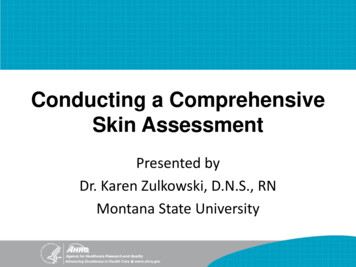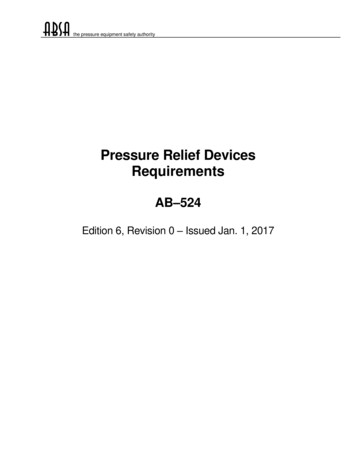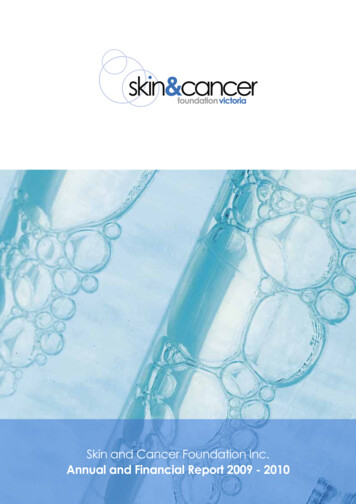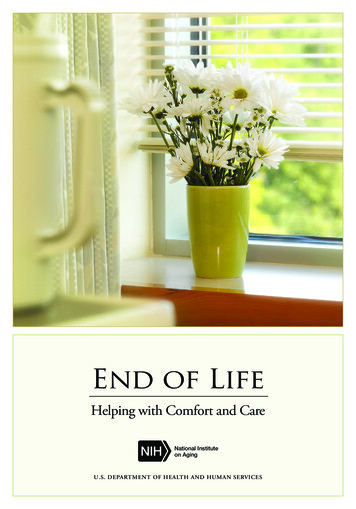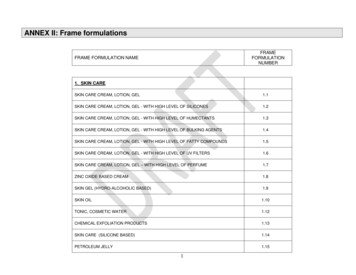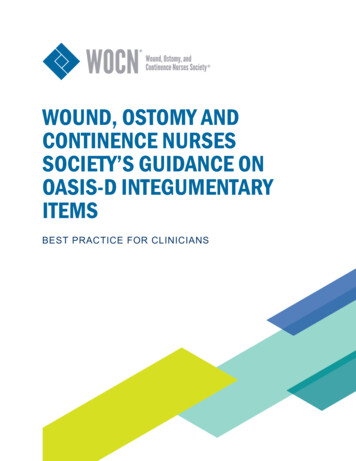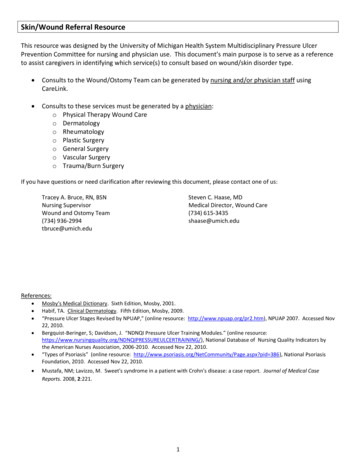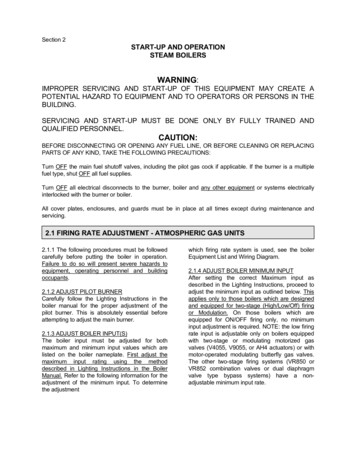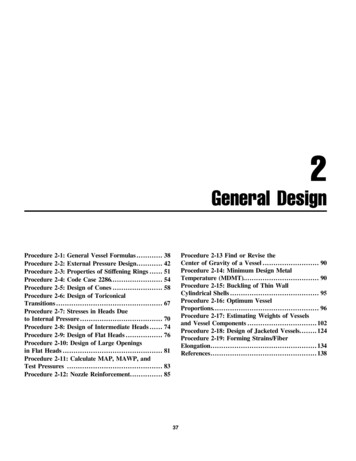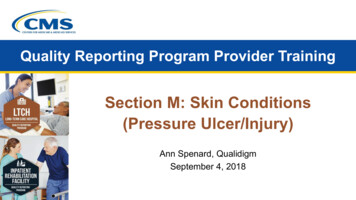
Transcription
Quality Reporting Program Provider TrainingSection M: Skin Conditions(Pressure Ulcer/Injury)Ann Spenard, QualidigmSeptember 4, 2018IRF-PAI v2.0LTCH CARE Data Set v4.00 Section M September 20181
Housekeeping This webinar is being recorded Closed captioning is enabled and will appear at thebottom of your screen If you have a question at any point throughout today’spresentation, enter it at the bottom of the Q&A box in thelower left-hand corner of the screen. Submit by clickingthe “Ask” buttonIRF-PAI v2.0LTCH CARE Data Set v4.00 Section M September 20182
How to Download the Training Materials Training materials can be downloaded from:o LTCH Quality Reporting Training orting/LTCH-Quality-ReportingTraining.htmlo IRF Quality Reporting Training rting/IRF-Quality-Reporting-Training.html The Downloads section is at the bottom of the Training web pagesIRF-PAI v2.0LTCH CARE Data Set v4.00 Section M September 20183
How to Enter Full Screen Mode Click on the PowerPoint PresentationTitle located above the presentation area The option for FULL SCREEN willappear Click on FULL SCREEN to maximizeand change your view to ONLY thepresentation Hit the ESC key on your keyboard toreturn to the normal viewIRF-PAI v2.0LTCH CARE Data Set v4.00 Section M September 20184
Knowledge Check Questions During this presentation, you will be asked to respond to questionsthat test your knowledge of the material presented When prompted with a question, review the options offered andselect your answer by clicking the on-screen circle next to yourselection Once you select your answer, it will automatically be submitted foryou Following a brief pause, the presenter will review the correctresponses and rationale for each questionIRF-PAI v2.0LTCH CARE Data Set v4.00 Section M September 20185
How many people (including yourself) areattending this webinar together?A. Just me—I am the only one participatingB. Two peopleC. Three or four peopleD. Five or more peopleIRF-PAI v2.0LTCH CARE Data Set v4.00 Section M September 20186
DisclaimerThis presentation was current at the time it was published or uploaded onto theweb. Medicare policy changes frequently, so links to the source documentshave been provided within the document for your reference.This presentation was prepared as a service to the public and is not intended togrant rights or impose obligations. This presentation may contain references orlinks to statutes, regulations, or other policy materials. The information providedis only intended to be a general summary. It is not intended to take the place ofeither the written law or regulations. We encourage readers to review thespecific statutes, regulations, and other interpretive materials for a full andaccurate statement of their contents.IRF-PAI v2.0LTCH CARE Data Set v4.00 Section M September 20187
Today’s PresenterAnn M. Spenard, D.N.P., R.N.-BCVice President & PrincipalQualidigmIRF-PAI v2.0LTCH CARE Data Set v4.00 Section M September 20188
Acronyms in This Presentation Ankle Foot Orthosis (AFO)Centers for Medicare & Medicaid Services (CMS)Deep Tissue Injury (DTI)Inpatient Rehabilitation Facility (IRF)Inpatient Rehabilitation Facility Patient Assessment Instrument(IRF-PAI) Long-Term Care Hospital (LTCH) LTCH Continuity Assessment Record and Evaluation(LTCH CARE) Data SetIRF-PAI v2.0LTCH CARE Data Set v4.00 Section M September 20189
Acronyms in This Presentation (cont.) National Pressure Ulcer Advisory Panel (NPUAP) Peripheral Arterial Disease (PAD) Peripheral Vascular Disease (PVD) Post-Acute Care (PAC) Quality Measure (QM) Quality Reporting Program (QRP) Skilled Nursing Facility (SNF)IRF-PAI v2.0LTCH CARE Data Set v4.00 Section M September 201810
Overview Define Section M: Skin Conditions Explain the intent of Section M Explain new items and/or changes Discuss coding instructions for items Review practice coding scenariosIRF-PAI v2.0LTCH CARE Data Set v4.00 Section M September 201811
ObjectivesState the intent of the changes toSection MDescribe the new pressure ulcer/injuryquality measure (QM)Articulate the purpose of the new pressureulcer terminology and any implications forcodingApply coding instructions to accuratelycode practice scenariosIRF-PAI v2.0LTCH CARE Data Set v4.00 Section M September 201812
Intent Document the presence,appearance, and change in status ofpressure ulcers/injuries based on acomplete and ongoing assessment ofpatient’s skin guided by clinicalstandards Promote effective pressureulcer/injury prevention and skinmanagement program for all patientsIRF-PAI v2.0LTCH CARE Data Set v4.00 Section M September 2018Pressure Ulcer/Injury:Localized injury to the skin and/orunderlying tissue, usually over abony prominence, as a result ofintense and/or prolonged pressure,or pressure in combination withshear. The pressure ulcer/injurycan present as intact skin or anopen ulcer and may be painful.13
Changes in Skin IntegrityPost-Acute Care:Pressure Ulcer/InjuryIRF-PAI v2.0LTCH CARE Data Set v4.00 Section M September 201814
Changes in Skin Integrity Post-Acute Care:Pressure Ulcer/Injury M0300 items will be used to calculate the new quality measure“Changes in Skin Integrity Post-Acute Care: Pressure Ulcer/Injury”Data collection beganJuly 1, 2018, for Long TermCare Hospitals (LTCHs)IRF-PAI v2.0LTCH CARE Data Set v4.00 Section M September 2018Data collection beginsOctober 1, 2018, for InpatientRehabilitation Facilities (IRFs)15
Changes in Skin Integrity Post-Acute Care:Pressure Ulcer/Injury (cont.) For this measure, an ulcer/injury isconsidered new or worsened at dischargeif the Discharge Assessment shows aStage 2–4 or unstageable pressureulcer/injury that was not present onadmission at that stage (e.g., M0300B1–M0300B2 0)IRF-PAI v2.0LTCH CARE Data Set v4.00 Section M September 201816
Pressure Ulcer/Injury: Numerator/DenominatorIRF-PAI v2.0LTCH CARE Data Set v4.00 Section M September 201817
Pressure Ulcer/Injury: Denominator ExclusionsPatient stay is excluded if:Data on new or worsenedStage 2, 3, 4, andunstageable pressure ulcers,including deep tissue injuries,are missing on the DischargeAssessmentIRF-PAI v2.0LTCH CARE Data Set v4.00 Section M September 2018The patient died duringthe stay18
Pressure Ulcer/Injury: Measure Time WindowThe measure will be calculated quarterly using a rolling 12 monthsof data. For public reporting, the quality measure score reportedfor each quarter is calculated using a rolling 12 months of dataAll patient stays during the 12 months, except those that meet theexclusion criteria, are included in the denominator and are eligiblefor inclusion in the numeratorFor patients with multiple stays during the 12-month time window,each stay is eligible for inclusion in the measureIRF-PAI v2.0LTCH CARE Data Set v4.00 Section M September 201819
Pressure Ulcer/Injury: Risk AdjustmentAdmission Assessment items used to risk-adjust this quality measure:Functional MobilityAdmission PerformanceBowel Continence GG0170C. Mobility; Lying to Sitting on Side ofBed H0400. Bowel ContinencePeripheral VascularDisease/Peripheral ArterialDisease or Diabetes Mellitus I0900. Peripheral Vascular Disease (PVD) or PeripheralArterial Disease (PAD) I2900. Diabetes MellitusLow Body Mass Index,based on Height and Weight K0200A (LTCH) or 25A (IRF). Height K0200B (LTCH) or 26A (IRF). WeightIRF-PAI v2.0LTCH CARE Data Set v4.00 Section M September 201820
Section M: Skin ConditionsChangesIRF-PAI v2.0LTCH CARE Data Set v4.00 Section M September 201821
Item Changes CMS is aware of the array of terms usedto describe alterations in skin integritydue to pressure, including pressure ulcer,pressure injury, pressure sore, decubitusulcer, and bed sore It is acceptable to code pressure-relatedskin conditions in Section M if differentterminology is recorded in the clinicalrecord, if the primary cause of the skinalteration is related to pressureIRF-PAI v2.0LTCH CARE Data Set v4.00 Section M September 201822
Item Changes (cont. 1)CMS adheres to the following guidelines:Stage 1 pressure injuriesand deep tissue injuriesare termed “pressureinjuries” because they areclosed woundsStage 2, 3, or 4 pressureulcers, or unstageableulcers due to slough oreschar, are termed“pressure ulcers”because they are usuallyopen woundsIRF-PAI v2.0LTCH CARE Data Set v4.00 Section M September 2018Unstageableulcers/injuries due tononremovabledressing/device aretermed “pressureulcers/injuries” becausethey may be open orclosed wounds23
Item Changes (cont. 2) The term “injuries” has been added to items: M0210, M0300, M0300A,M0300E–M0300E2, and M0300G–M0300G2IRF-PAI v2.0LTCH CARE Data Set v4.00 Section M September 201824
Item Changes (cont. 3) The term “device” was added to items: M0300E–M0300E2IRF-PAI v2.0LTCH CARE Data Set v4.00 Section M September 201825
Item Changes (cont. 4) Removed the term “suspected deep tissue injury in evolution” and replacedwith “deep tissue injury” to items M0300G and M0300G1IRF-PAI v2.0LTCH CARE Data Set v4.00 Section M September 201826
Item Changes (cont. 5) M0800A–M0800F, Worsening inPressure Ulcer Status Since Admission,items have been removed IRFs Only: M0900A–M0900D, HealedPressure Ulcer(s), items have beenremoved from IRF-PAIIRF-PAI v2.0LTCH CARE Data Set v4.00 Section M September 201827
Section M: Skin ConditionsCoding Guidance and Practice CodingScenariosIRF-PAI v2.0LTCH CARE Data Set v4.00 Section M September 201828
M0300. Current Number of Unhealed PressureUlcers/Injuries at Each StageM0300A1–G1 Identifies number ofunhealed pressureulcers/injuriesat each stage Establishes the patient’sbaseline assessmentAdmissionAssessmentIRF-PAI v2.0LTCH CARE Data Set v4.00 Section M September 2018M0300A1–G1 Identifies number of unhealed pressureulcers/injuries at each stageM0300B2–G2 At the time of discharge, identifies if theunhealed pressure ulcers/injuries inM0300A1–G1 were present on admissionor if the pressure ulcers/injuries wereacquired or worsened during the stayDischarge Assessment(For LTCH: Planned orUnplanned)29
Medical DocumentationUse documentation fromthe previous setting toinform about the originalstage of a pressureulcer/injuryReview the history ofeach pressureulcer/injury in thepatient’s medicalrecordIRF-PAI v2.0LTCH CARE Data Set v4.00 Section M September 201830
Steps for Completing M0300A–G1. Determine DeepestAnatomical Stage2. Identify Unstageable PressureUlcers/InjuriesIRF-PAI v2.0LTCH CARE Data Set v4.00 Section M September 201831
Steps for Completing M0300A–G (cont.)3. For the Discharge Assessment,determine the number ofpressure ulcers/injuries that werepresent on admissionFor detailed instructions, refer to Section M in theLTCH Quality Reporting Program (QRP) Manualand the Quality Indicator Section of the InpatientRehabilitation Facility Patient AssessmentInstrument (IRF-PAI) ManualIRF-PAI v2.0LTCH CARE Data Set v4.00 Section M September 201832
M0300. Current Number of Unhealed PressureUlcers/Injuries at Each Stage (Admission)IRF-PAI v2.0LTCH CARE Data Set v4.00 Section M September 201833
M0300A1–G1 Coding InstructionsIRF and LTCH: Completed at admissionand discharge(LTCH: A0250 01 Admission, 10 PlannedDischarge, or 11 Unplanned Discharge) Enter the number of pressure ulcers/injuries that are currentlypresent Enter 0 if no pressure ulcers/injuries are presentIRF-PAI v2.0LTCH CARE Data Set v4.00 Section M September 201834
M0300. Current Number of Unhealed PressureUlcers/Injuries at Each Stage (Discharge)IRF-PAI v2.0LTCH CARE Data Set v4.00 Section M September 201835
M0300. Current Number of Unhealed PressureUlcers/Injuries at Each Stage (Discharge) (cont.)IRF-PAI v2.0LTCH CARE Data Set v4.00 Section M September 201836
M0300B2–G2 Coding InstructionsIRF and LTCH: Completed only at discharge(LTCH: A0250 10 Planned Discharge or 11Unplanned Discharge) Enter the number of these pressure ulcers/injuries that werepresent on admission– See instructions under Steps for Completing M0300A–G, Step 3:Determine “Present on Admission” Enter 0 if no pressure ulcers/injuries were noted at the time ofadmissionIRF-PAI v2.0LTCH CARE Data Set v4.00 Section M September 201837
Present on AdmissionM0300B2–G2 The present on admission items (M0300B2–G2) are coded atdischarge Address whether the pressure ulcers/injuries observed atdischarge were:1Present on admission2Acquired or worsenedduring the stayIRF-PAI v2.0LTCH CARE Data Set v4.00 Section M September 201838
Present on AdmissionM0300B2–G2 (cont.)A pressure ulcer/injury reported at discharge and codedas not Present on Admission on the DischargeAssessment would be interpreted as new or worsenedA pressure ulcer/injury reported at discharge and codedas Present on Admission on the DischargeAssessment, would not be considered new or worsenedIRF-PAI v2.0LTCH CARE Data Set v4.00 Section M September 201839
Pressure Ulcers:Program Interruption If a patient is transferred from the post-acutecare (PAC) setting to an acute care hospital andreturns within 3 days (including the day oftransfer), the transfer is considered a programinterruption and is not considered a newadmission Therefore, any new pressure ulcer/injuryformation, or increase in numerical staging thatoccurs during the program interruption shouldnot be coded as “present on admission”IRF-PAI v2.0LTCH CARE Data Set v4.00 Section M September 201840
Practice Coding Scenario 1 A patient is admitted to the PAC settingwith a Stage 2 pressure ulcer to the lefthip. The patient is transported to anacute care hospital and returns to thePAC setting within 2 days Upon return to the PAC setting, the lefthip pressure ulcer is a full thicknessulcer assessed to be a Stage 3. Thepatient is discharged to home with thisStage 3 pressure ulcerIRF-PAI v2.0LTCH CARE Data Set v4.00 Section M September 2018Photo of a Medical Record41
How would you code M0300on the Admission Assessment?A. M0300B1. Stage 2 1B. M0300C1. Stage 3 1C. M0300D1. Stage 4 2D. M0300G1. Unstageable –Deep tissue injury (DTI) 1IRF-PAI v2.0LTCH CARE Data Set v4.00 Section M September 201842
How would you code M0300on the Discharge Assessment?A. M0300B1. Stage 2 1B. M0300C1. Stage 3 1C. M0300D1. Stage 4 2D. M0300G1. Unstageable – DTI 1IRF-PAI v2.0LTCH CARE Data Set v4.00 Section M September 201844
Unstageable Pressure Ulcers/InjuriesVisual inspection of the wound bed is necessary for accurate stagingPressure ulcers that have eschar or slough tissue present such that theanatomic depth of soft tissue damage cannot be visually inspected orpalpated in the wound bed should be classified as unstageableIf the wound bed is only partially covered by eschar or slough, and the extentof soft tissue damage can be visually inspected or palpated, the ulcer shouldbe numerically staged and should not be coded as unstageableIRF-PAI v2.0LTCH CARE Data Set v4.00 Section M September 201849
Practice Coding Scenario 2 A patient is admitted to the PAC settingwith a Stage 4 pressure ulcer on her lefthip When the pressure ulcer is reassessed atdischarge, it is entirely covered witheschar and the wound bed cannot beassessed. The patient is discharged withan unstageable pressure ulcer due toslough/escharIRF-PAI v2.0LTCH CARE Data Set v4.00 Section M September 201850
How would you code M0300on the Admission Assessment?A. M0300C1. Stage 3 1B. M0300D1. Stage 4 1C. M0300F1. Unstageable – slough and/oreschar 1D. M0300G1. Unstageable – DTI 1IRF-PAI v2.0LTCH CARE Data Set v4.00 Section M September 201851
How would you code M0300on the Discharge Assessment?A. M0300C1. Stage 3 1B. M0300D1. Stage 4 1C. M0300F1. Unstageable – slough and/oreschar 1D. M0300G1. Unstageable – DTI 1IRF-PAI v2.0LTCH CARE Data Set v4.00 Section M September 201853
Was this unstageable pressure ulcer due to sloughand/or eschar present on admission?A. Yes, code M0300F2 1B. No, code M0300F2 0C. Skip M0300F2IRF-PAI v2.0LTCH CARE Data Set v4.00 Section M September 201855
Non-Removable Dressing/Device Non-removabledressing/device refers to adressing or device that maynot be removed from thepatient per physician’sorderIRF-PAI v2.0LTCH CARE Data Set v4.00 Section M September 201861
Non-Removable Dressing/Device (cont. 1)Known pressureulcers/injuriescovered by a nonremovabledressing/deviceshould be codedas unstageableThese pressure ulcers/injuries areconsidered unstageable due to theinability to further assess thedocumented pressure ulcer/injury thatis covered by the non-removabledressing/deviceIRF-PAI v2.0LTCH CARE Data Set v4.00 Section M September 201862
Non-Removable Dressing/Device (cont. 2) “Known” refers to whendocumentation is available indicatingthat a pressure ulcer/injury existsunder the non-removabledressing/device Presence of the pressure ulcer/injuryshould have been previouslydocumented in the patient medicalrecordIRF-PAI v2.0LTCH CARE Data Set v4.00 Section M September 201863
Practice Coding Scenario 3 A patient is admitted to the PAC setting with documentationin the medical record of a sacral pressure ulcer/injury. Thisulcer/injury is covered with a non-removable dressing;therefore, this pressure ulcer/injury is unstageable On Day 4 of the stay, the dressing is removed by thephysician and assessment reveals a Stage 3 pressureulcer On Day 9 of the stay, the pressure ulcer is covered witheschar and is assessed as unstageable. The escharcovered ulcer is unchanged at the time of dischargeIRF-PAI v2.0LTCH CARE Data Set v4.00 Section M September 201864
How would you code M0300on the Admission Assessment?A. M0300C1. Stage 3 1B. M0300E1. Unstageable – Nonremovable dressing/device 1C. M0300F1. Unstageable – Slough and/oreschar 1D. M0300G1. Unstageable – DTI 1IRF-PAI v2.0LTCH CARE Data Set v4.00 Section M September 201865
How would you code M0300on the Discharge Assessment?A. M0300C1. Stage 3 1B. M0300E1. Unstageable – Nonremovable dressing/device 1C. M0300F1. Unstageable – Slough and/oreschar 1D. M0300G1. Unstageable – DTI 1IRF-PAI v2.0LTCH CARE Data Set v4.00 Section M September 201867
Was this unstageable pressure ulcer due to sloughand/or eschar present on admission?A. Yes, code M0300F2 1B. No, code M0300F2 0C. Skip M0300F2IRF-PAI v2.0LTCH CARE Data Set v4.00 Section M September 201869
Practice Coding Scenario 4 A patient is admitted to the PAC setting with a Stage3 pressure ulcer on her coccyx On Day 5 of her PAC stay the ulcer is assessed as aStage 4 pressure ulcer. She is seen at the woundclinic and returns to the PAC setting with a dressingand orders that the dressing is to remain intact untilthe next clinic visit The patient is discharged to a Skilled Nursing Facility(SNF) prior to the follow-up wound clinic visit. At thetime of discharge, this ulcer is covered with a nonremovable dressingIRF-PAI v2.0LTCH CARE Data Set v4.00 Section M September 201875
How would you code M0300on the Admission Assessment?A. M0300C1. Stage 3 1B. M0300D1. Stage 4 1C. M0300E1. Unstageable – Non-removabledressing/device 1D. M0300F1. Unstageable – Slough and/oreschar 1IRF-PAI v2.0LTCH CARE Data Set v4.00 Section M September 201876
How would you code M0300on the Discharge Assessment?A. M0300C1. Stage 3 1B. M0300D1. Stage 4 1C. M0300E1. Unstageable – Non-removabledressing/device 1D. M0300F1. Unstageable – Slough and/oreschar 1IRF-PAI v2.0LTCH CARE Data Set v4.00 Section M September 201878
Was this unstageable pressure ulcer/injury due to Nonremovable dressing/device present on admission?A. Yes, code M0300E2 1B. No, code M0300E2 0C. Skip M0300E2IRF-PAI v2.0LTCH CARE Data Set v4.00 Section M September 201880
Healed Pressure Ulcers/InjuriesTerminology referring to “healed” vs. “unhealed”ulcers/injuries refers to whether the ulcer/injury is“closed” vs. “open”Stage 1 pressure injuries, deep tissue injuries (DTIs), andunstageable pressure ulcers—although covered with tissue,eschar, or slough—would not be considered healedIRF-PAI v2.0LTCH CARE Data Set v4.00 Section M September 201885
Practice Coding Scenario 5 The patient’s skin assessment on admissionto PAC reveals no pressure ulcers or injuries On Day 5, while conducting a skinassessment, a Stage 2 pressure ulcer isidentified on the right elbow On discharge, the patient’s skin assessmentreveals a healed Stage 2 pressure ulcer onthe right elbowIRF-PAI v2.0LTCH CARE Data Set v4.00 Section M September 201886
How would you code M0210on the Admission Assessment?Does this patient have one or moreunhealed pressure ulcers/injuries?A. 0, NoB. 1, YesIRF-PAI v2.0LTCH CARE Data Set v4.00 Section M September 201887
How would you code M0210on the Discharge Assessment?Does this patient have one or moreunhealed pressure ulcers/injuries?A. 0, NoB. 1, YesIRF-PAI v2.0LTCH CARE Data Set v4.00 Section M September 201889
Practice Coding Scenario 6 A patient is admitted to the PAC settingwith a Stage 1 pressure injury on thecoccyx The skin assessment of the tissuessurrounding this injury on Day 6 isconsistent with a DTI This DTI remains intact at the time ofdischarge to home 3 days laterIRF-PAI v2.0LTCH CARE Data Set v4.00 Section M September 201892
How would you code M0300on the Admission Assessment?A. M0300A1. Stage 1 1B. M0300B1. Stage 2 1C. M0300F1. Unstageable – Slough and/oreschar 1D. M0300G1. Unstageable – DTI 1IRF-PAI v2.0LTCH CARE Data Set v4.00 Section M September 201893
How would you code M0300on the Discharge Assessment?A. M0300A1. Stage 1 1B. M0300B1. Stage 2 1C. M0300F1. Unstageable – Slough and/oreschar 1D. M0300G1. Unstageable – DTI 1IRF-PAI v2.0LTCH CARE Data Set v4.00 Section M September 201895
Was this unstageable pressure injury presenton admission?A. Yes, code M0300G2 1B. No, code M0300G2 0C. Skip M0300G2IRF-PAI v2.0LTCH CARE Data Set v4.00 Section M September 201897
Medical Device Related Pressure Ulcers When an ulcer/injury is caused due to the use of amedical device, assess the area to determine ifpressure is the primary cause. These ulcers/injuriesgenerally conform to the pattern or shape of thedevice If pressure is determined to be the primary cause,use the staging system to stage the ulcer/injury andcode in Section M of the LTCH CARE Data Set orIRF-PAI. If the ulcer/injury is not due to pressure, donot code it in Section MIRF-PAI v2.0LTCH CARE Data Set v4.00 Section M September 2018102
Practice Coding Scenario 7 A patient is admitted to PAC with a right anklefoot orthosis (AFO) to compensate forweakness and foot drop On the initial skin assessment, the cliniciannotes a Stage 2 pressure ulcer at the rightcalf, that conforms to the shape of the AFO.The orthotist is consulted and the AFO isadjusted The ulcer heals before discharge and noother pressure ulcers/injuries are presentIRF-PAI v2.0LTCH CARE Data Set v4.00 Section M September 2018103
How would you code M0210on the Admission Assessment?Does this patient have one or moreunhealed pressure ulcers/injuries?A. 0, NoB. 1, YesIRF-PAI v2.0LTCH CARE Data Set v4.00 Section M September 2018104
How would you code M0300on the Admission Assessment?A. M0300A1. Stage 1 1B. M0300B1. Stage 2 1C. M0300E1. Unstageable – Nonremovable dressing/device 1D. M0300G1. Unstageable – DTI 1IRF-PAI v2.0LTCH CARE Data Set v4.00 Section M September 2018106
How would you code M0210on the Discharge Assessment?Does this patient have one or moreunhealed pressure ulcers/injuries?A. 0, NoB. 1, YesIRF-PAI v2.0LTCH CARE Data Set v4.00 Section M September 2018108
Mucosal Ulcers Mucosal pressure ulcers are not staged usingthe skin pressure ulcer/injury staging systembecause anatomical tissue comparisons cannotbe made Therefore, mucosal ulcers (e.g., those relatedto nasogastric tubes, oxygen tubing,endotracheal tubes, urinary catheters, mucosalulcers in the oral cavity) should not be coded onthe LTCH CARE Data Set or IRF-PAIIRF-PAI v2.0LTCH CARE Data Set v4.00 Section M September 2018114
Kennedy UlcersSkin ulcers that occur atthe end of life are knownas Kennedy or terminalulcers Kennedy (terminal)skin ulcers are notcaptured in Section MIRF-PAI v2.0LTCH CARE Data Set v4.00 Section M September 2018Evolution andappearance differ from atypical pressureulcer/injury Related to tissueperfusion issues due toorgan and skin failure115
Summary To be inclusive of updated terminologysupported by NPUAP, the term“injuries” has been added in theSection M heading of the following items:– M0210– M0300 and M0300A– M0300E, M0300E1, and M0300E2– M0300G, M0300G1, and M0300G2IRF-PAI v2.0LTCH CARE Data Set v4.00 Section M September 2018116
Summary (cont.) Removed the term “suspected deep tissue injuryin evolution” and replaced with “deep tissueinjury” to items:– M0300G and M0300G1 To improve clarity, the term “device” was addedto items:– M0300E, M0300E1, and M0300E2 Removed items M0800A–M0800F Removed items M0900A–M0900D from IRF-PAIIRF-PAI v2.0LTCH CARE Data Set v4.00 Section M September 2018117
FY 2019 IRF and LTCH Rule Updates The final rules removed the following measures from the IRF QRP and LTCH QRP:– IRF and LTCH National Healthcare Safety Network (NHSN) Facility-wide Inpatient Hospital-onset Methicillin-resistantStaphylococcus aureus (MRSA) Bacteremia Outcome Measure (NQF #1716) beginning with the FY 2020IRF and LTCH QRPs.– Beginning October 1, 2018, IRFs and LTCHs will no longer be required to submit data on thismeasure for the purposes of the IRF and LTCH QRPs. Percent of Residents or Patients Who Were Assessed and Appropriately Given the Seasonal InfluenzaVaccine (Short Stay) (NQF #0680) beginning with the FY 2021 IRF and LTCH QRPs.– Beginning October 1, 2018, IRFs/LTCHs should enter any of the valid codes or a dash (–) forO0250A, O0250B, and O0250C until the next IRF-PAI and LTCH CARE Data Set is released.– LTCH-only National Healthcare Safety Network (NHSN) Ventilator-Associated Event (VAE) Outcome Measurebeginning with the FY 2020 LTCH QRP.– Beginning October 1, 2018, LTCHs will no longer be required to submit data on this measure for thepurposes of the LTCH QRP.IRF-PAI v2.0LTCH CARE Data Set v4.00 Section M September 2018118
FY 2019 IRF and LTCH Rule Updates (cont.) Further, CMS finalized the following:– An update to expand the methods by which IRFs and LTCHs are notified of noncompliancewith the requirements of the IRF and LTCH QRPs for a program year and how CMS willnotify IRFs and LTCHs of a reconsideration decision.– IRF-only: To display data on the four assessment-based functional outcome measures inCY 2020. For more information, refer to the final rules:– FY 2019 IRF PPS final rule: 1816517.pdf– FY 2019 IPPS/LTCH PPS final rule: 8-16766.pdfIRF-PAI v2.0LTCH CARE Data Set v4.00 Section M September 2018119
IRF-PAI v2.0LTCH CARE Data Set v4.00 Section M September 2018120
Changes in Skin Integrity Post-Acute Care: Pressure Ulcer/Injury (cont.) For this measure, an ulcer/injury is considered new or worsened at discharge if the Discharge Assessment shows a Stage 2–4 or
